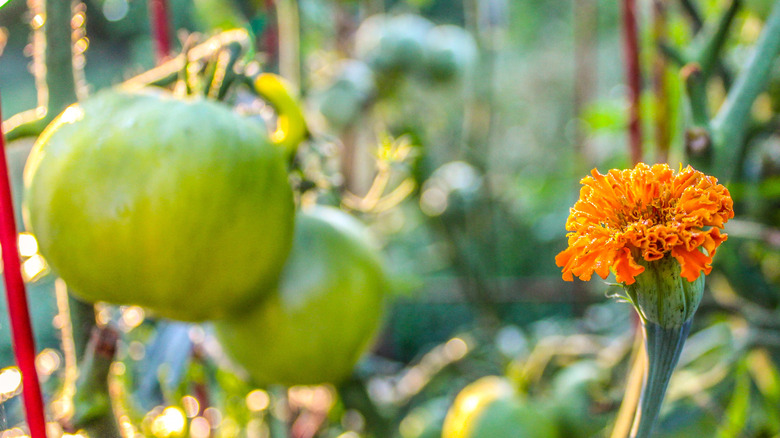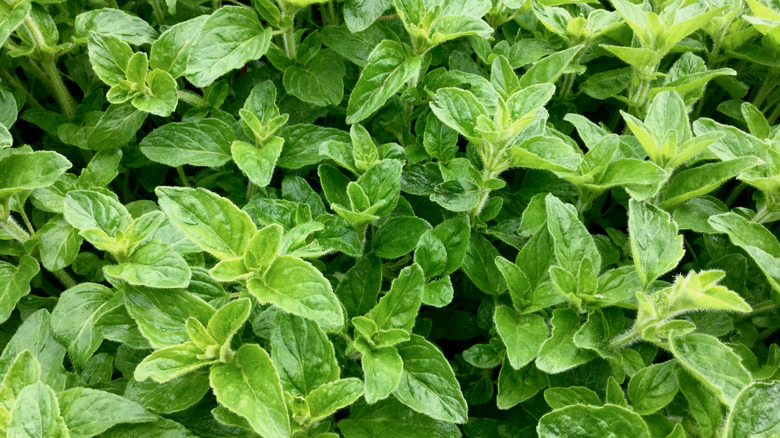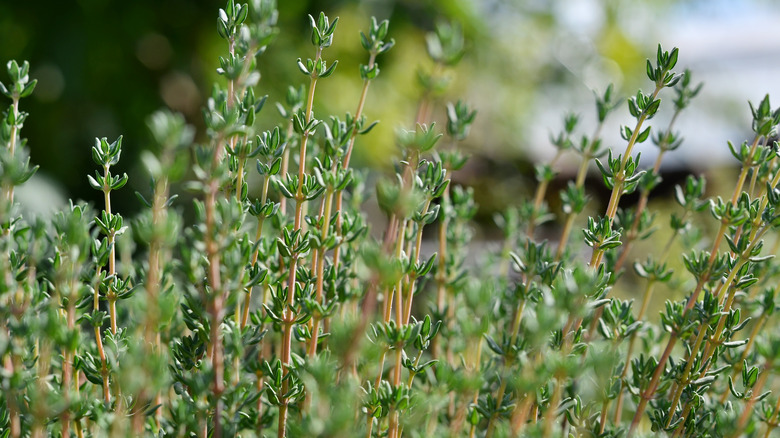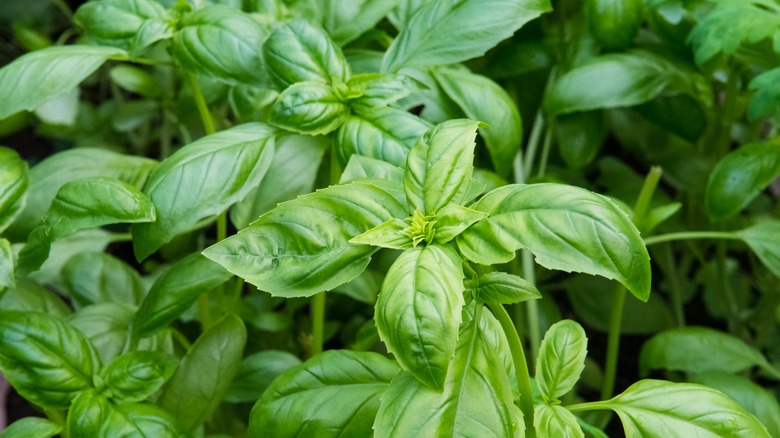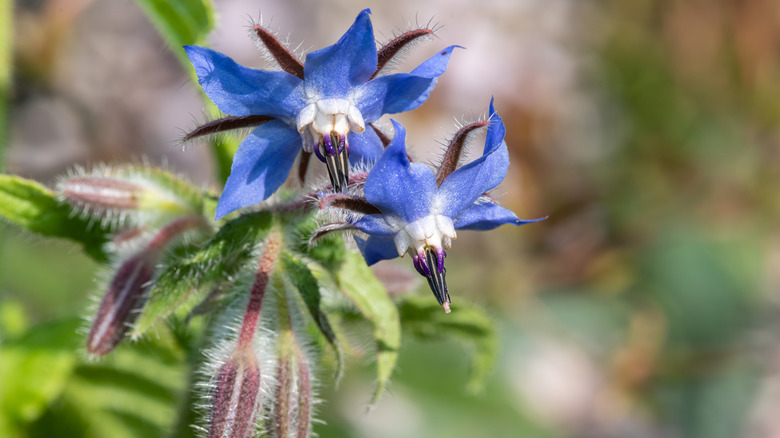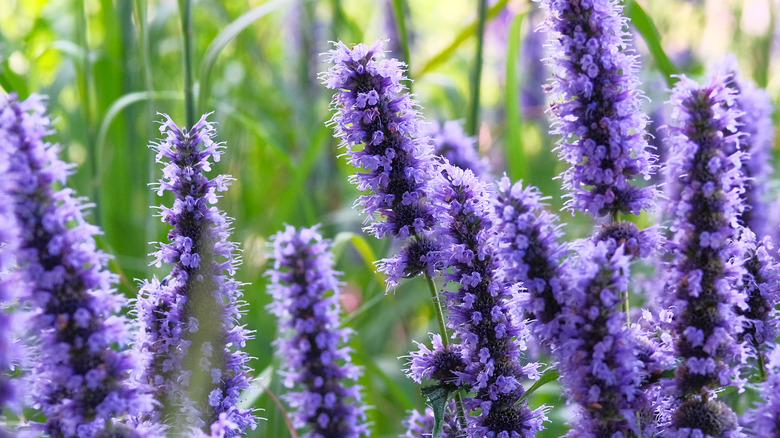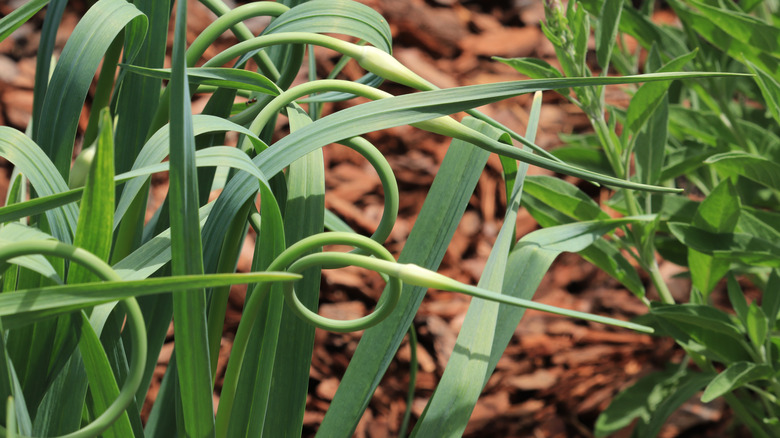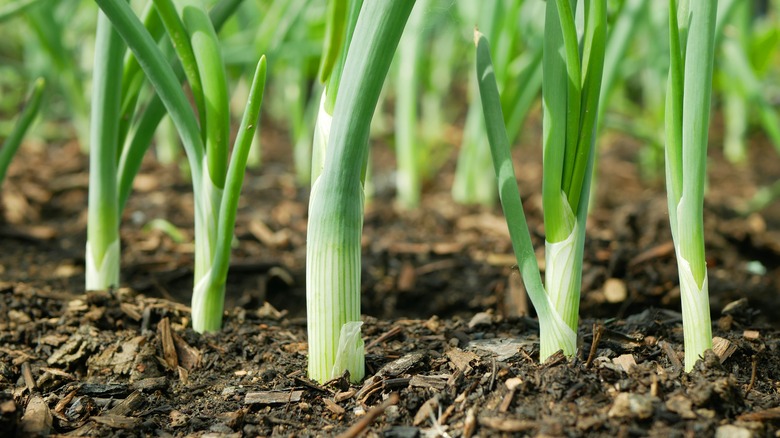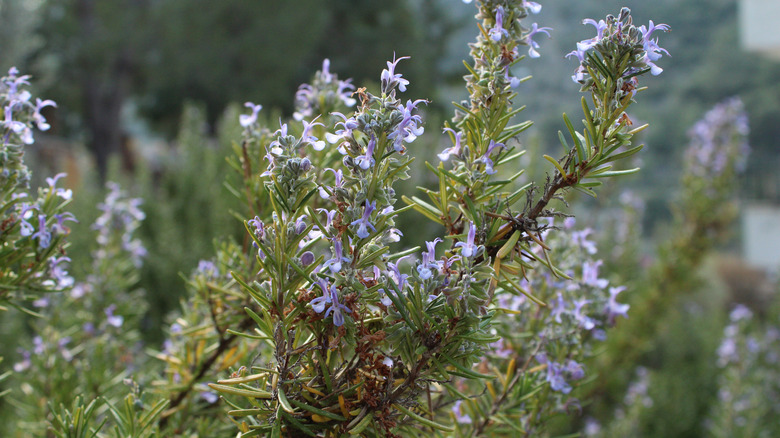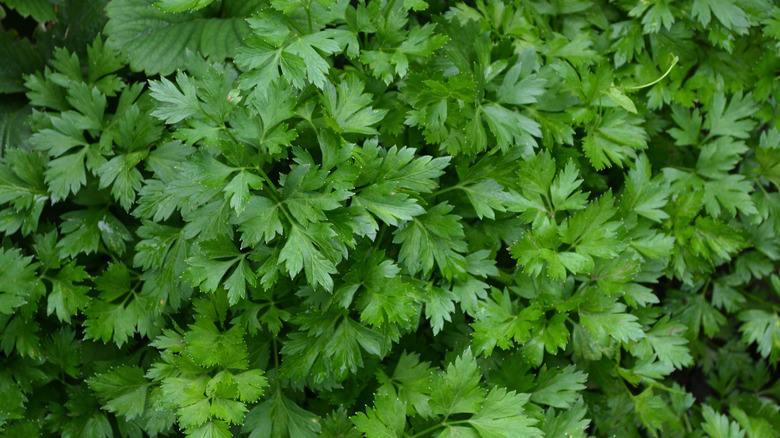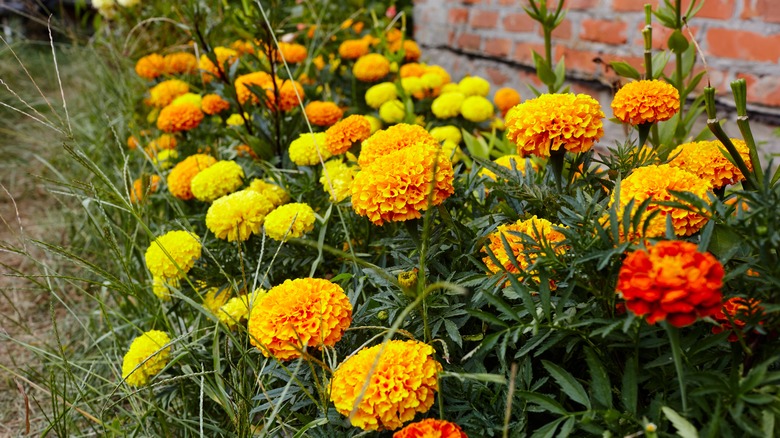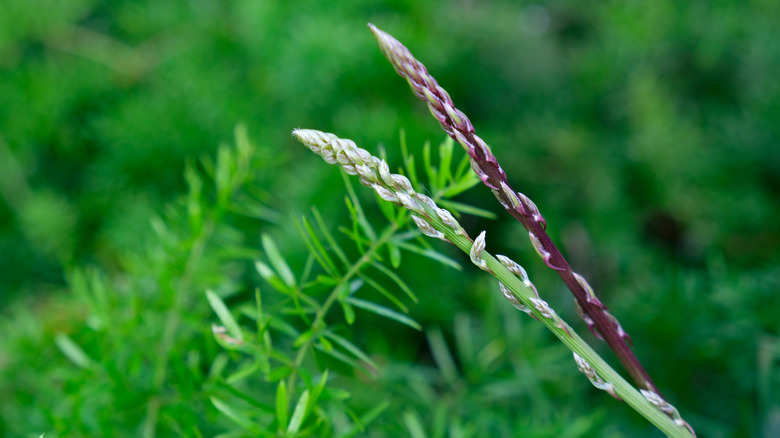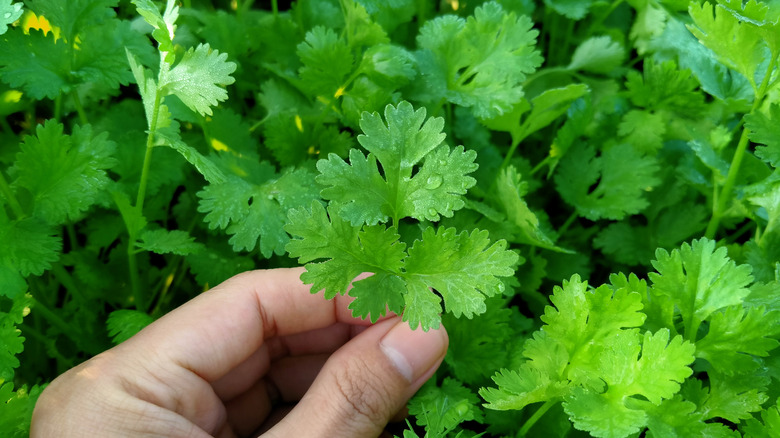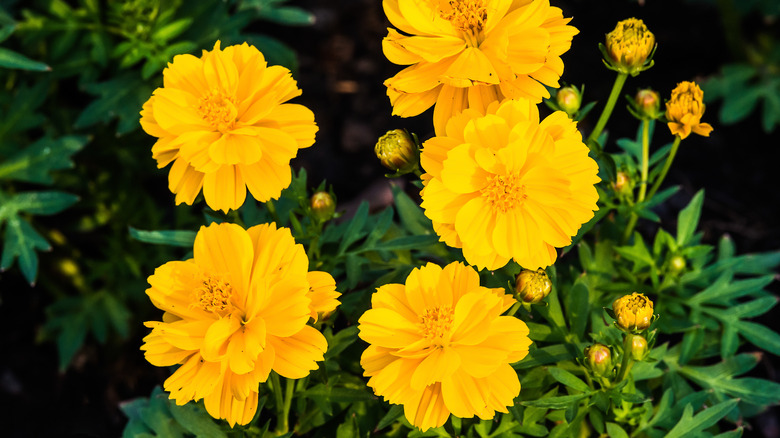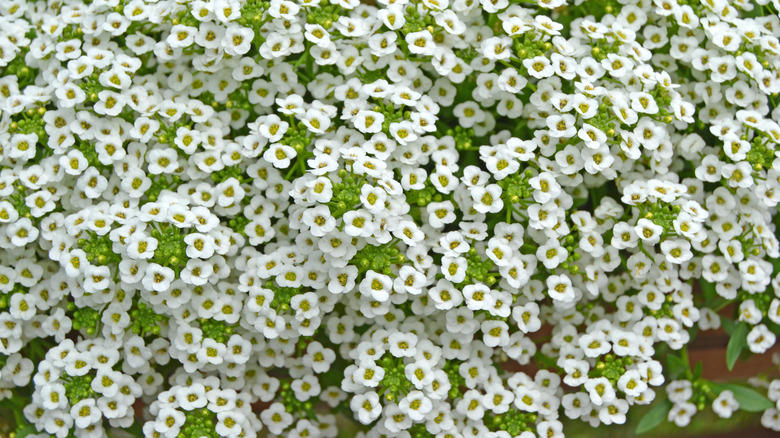15 Companion Plants You Should Grow Next To Tomatoes In Your Garden
As a beginner gardener, planting and growing tomatoes can be a difficult task. Tomatoes, while delicious, are a finicky annual that can become host to a range of problems, including disease, pests, and being destroyed by aggressive weeds, even if they are being cared for properly. One way that seasoned gardeners help their tomatoes grow strong and healthy is by planting companions around them. Companion plants are used to ward off harmful insects, weeds, root-knot nematodes, and pesky animals, as per the University of Minnesota Extension. They may also attract beneficial predatory insects and pollinators, as well as supplement soil health.
Even though diligent care and a watchful eye can often save your tomato plants from their most common enemies, companion plantings can easily save you time and money, while providing you with the additional benefit of more useful plants. Many of the tomato's most beneficial companion plantings are edible herbs that can be used in a fresh salad, pasta dish, or appetizer. Consider this list of possible companion plantings and dream up all the wonderful recipes you can try out fresh from your home garden.
1. Oregano
Oregano (Origanum vulgare) will be the perfect herb to plant next to your tomatoes for many reasons. As explained by Washington State University, this tasty herbaceous plant is tolerant of drought, and it has minimal pest problems. It won't steal necessary water and nutrients from your tomatoes and it might ward off pests too. Additionally, when you're making delicious homemade pasta sauce, your main ingredients are planted as neighbors.
Bloom Season: Summer
USDA Growing Zone: 3 to 9
Growing Conditions: Full sun to partial shade
Soil Type: Well-draining
Size: 2 feet tall and wide
2. Lemon balm
Lemon balm (Melissa officinalis) is well-known for its scent of lemons and low-maintenance care. Often, this herb is used for flavoring teas and fish dishes, however, as noted by Utah State University, it also wards off insects that detest the natural oils on the plant's foliage. Like tomatoes, lemon balm can grow in organically rich and well-draining soil that receives direct sunlight.
Bloom Season: Summer to fall
USDA Growing Zone: 3 to 7
Growing Conditions: Full sun to partial shade
Soil Type: Rich and well-draining
Size: 2 to 3 feet tall
3. Thyme
Thyme (Thymus vulgaris) is another herbaceous perennial that you won't regret planting near your tomato plants. As per North Carolina State Extension, garden thyme grows vigorously in dry soils with direct sunlight and good drainage. It is considered low-maintenance, yet you should prune it frequently so it doesn't become too leggy.
Bloom Season: Spring and summer
USDA Growing Zone: 5 to 9
Growing Conditions: Full sun
Soil Type: Evenly moist and well-draining
Size: 6 to 12 inches tall and wide
4. Basil
The basil plant (Ocimum basilicum), which is another member of the Lamiaceae family, is well-known for its culinary use in pasta, beef, and fish dishes, as noted by Missouri Botanical Garden. A lesser-known fact about basil is that it is one of the best companion plants for tomatoes. The two plants share a mutually beneficial relationship that makes both grow healthier and stronger.
Bloom Season: Summer to fall
USDA Growing Zone: 2 to 11
Growing Conditions: Full sun
Soil Type: Rich and well-draining
Size: 2 feet tall and wide
5. Borage
The borage plant (Borago officinalis) can be identified by its roughly textured foliage and its edible blooms that are blue and star-shaped. Its foliage repels Japanese beetles and tomato hornworms, as described by Washington College.
Bloom Season: Spring and summer
USDA Growing Zone: 6 to 9
Growing Conditions: Full sun to partial shade
Soil Type: Well-draining and sandy
Size: 3 feet tall
6. Hyssop
The hyssop flower (Hyssopus officinalis) is, all at once, ornamental, medicinal, fragrant, and a great companion plant to tomatoes. This versatile herb can be planted around your garden, where it will grow happily in a sunny location with well-draining soil, states High Country Gardens. Its leaves are resistant to pesky animals such as deer and bunnies, yet this plant is loved by many types of bees looking for nectar.
Bloom Season: Summer
USDA Growing Zone: 4 to 9
Growing Conditions: Full sun
Soil Type: Well-draining
Size: 18 to 24 inches tall and 12 to 15 inches wide
7. Garlic
Garlic (Allium sativum) has a long history of being grown in a range of climates where it has acted as an annual that can only be propagated from bulbs, according to the University of Wisconsin-Madison. The garden plant does best in organic and well-draining soil that receives direct sunlight. The bulbs can be harvested around the same time as tomatoes in the late summer.
Bloom Season: Spring
USDA Growing Zone: 7 to 10
Growing Conditions: Full sun
Soil Type: Organic and well-draining
Size: Up to 3 feet tall
8. Onion
Onions (Allium cepa) are relatives of garlic, so they naturally need similar growing conditions, and they have the same companion plants. When planted in an edible garden with tomatoes, they won't compete for essential nutrients, and they help repel harmful bugs. North Carolina State Extension notes that onions also deter deer and rabbits.
Bloom Season: Summer
USDA Growing Zone: 5 to 10
Growing Conditions: Full sun
Soil Type: Organic and well-draining
Size: 30 inches tall and 1 foot wide
9. Rosemary
Rosemary plants (Salvia rosmarinus) are a species of tall-growing, flowering shrubs that bear edible foliage used in a range of dishes. This generally pest-free plant enjoys full sun conditions, but it is not particular about the soil that it is planted in, says RHS. When grown near tomatoes, the rosemary bush may be pruned into a low hedge to keep it from shading its fruit-producing companion plant.
Bloom Season: Spring and summer
USDA Growing Zone: 8 to 10
Growing Conditions: Full sun
Soil Type: Well-draining
Size: 8 feet tall and wide
10. Parsley
Parsley plants (Petroselinum crispum) are Mediterranean herbs featuring lots of aromatic foliage that carries essential oils that insects and some animals find repulsive. Some varieties of the plant can be grown for ornamental or culinary use depending on your needs. Like tomatoes, parsley can be interplanted with basil or marigolds, as suggested by the University of Wisconsin-Madison.
Bloom Season: Summer
USDA Growing Zone: 3 to 9
Growing Conditions: Full sun
Soil Type: Rich and well-draining
Size: 12 to 18 inches tall
11. French marigolds
French marigold flowers (Tagetes patula) are a garden staple throughout their long bloom season. Ohio State University identifies them as virtually pest and disease-free, which makes them a wonderful option in any edible garden looking to ward off harmful insects. An adaptable plant, french marigold flowers are also fragrant and edible.
Bloom Season: Spring to fall
USDA Growing Zone: 2 to 11
Growing Conditions: Full sun to partial shade
Soil Type: Moist and well-draining
Size: 6 to 12 inches tall and 8 to 18 inches wide
12. Asparagus
The perennial vegetable, asparagus (Asparagus officinalis), is known for its edible spears that are delicious when pickled, baked, or sauteed. The plant also produces pretty foliage, which can be used in floral arrangements or for visual interest in the garden, as pointed out by Missouri Botanical Garden. When planted alongside tomatoes, the asparagus plant can ward off rabbits too.
Bloom Season: Insignificant flowers in spring and summer
USDA Growing Zone: 3 to 10
Growing Conditions: Full sun
Soil Type: Organically rich and well-draining
Size: 3 to 4 feet tall and 1 to 2 feet wide
13. Cilantro
Cilantro (Coriandrum sativum) is commonly grown in cooler environments where it produces edible foliage throughout much of its growing season. Like tomatoes, this plant enjoys sunlight, well-draining soil, and even moisture. Cilantro plants also attract predatory insects and butterflies, as explained by North Carolina State Extension, which is very beneficial to the plants growing nearby.
Bloom Season: Summer
USDA Growing Zone: 2 to 11
Growing Conditions: Full sun to partial shade
Soil Type: Well-draining
Size: 1 to 2 feet tall and wide
14. Cosmos
Cosmo flowers (Cosmos spp.) are among the few brightly flowering plants that should be grown as companions to tomatoes. They grow very easily in most garden types that provide plenty of sunlight and warm weather. Utah State University states that cosmos have few issues in the garden other than their rapid spreading habit.
Bloom Season: Summer to fall
USDA Growing Zone: 2 to 11
Growing Conditions: Full sun
Soil Type: Well-draining
Size: Up to 5 feet tall
15. Sweet alyssum
Sweet alyssum (Lobularia maritima) is a low-growing flowering annual that grows best along the coast in direct sunlight, as said by the University of Wisconsin-Madison. However, with the ability to grow in a range of soil types and a few different climates, it will likely perform well in your home garden. Sweet alyssum grows well among many other flowers, fruits, herbs, and vegetables, including tomatoes, tulips, and roses.
Bloom Season: Spring to fall
USDA Growing Zone: 5 to 9
Growing Conditions: Full sun to partial shade
Soil Type: Well-draining
Size: 3 to 9 inches tall
